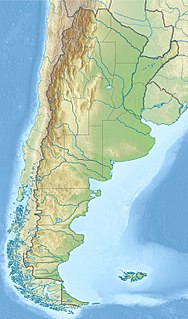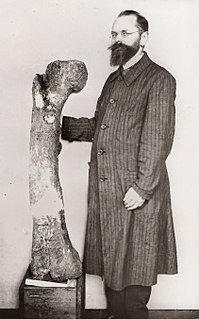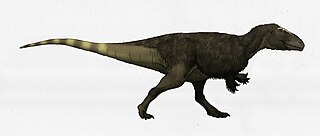
Argentinosaurus is a genus of giant sauropod dinosaur that lived during the Late Cretaceous period in what is now Argentina. Although it is only known from fragmentary remains, Argentinosaurus is one of the largest known land animals of all time, perhaps the largest, with length estimates ranging from 30 to 40 metres and weight estimates from 50 to 100 tonnes. It was a member of Titanosauria, the dominant group of sauropods during the Cretaceous.

Giganotosaurus is a genus of theropod dinosaur that lived in what is now Argentina, during the early Cenomanian age of the Late Cretaceous period, approximately 98 to 97 million years ago. The holotype specimen was discovered in the Candeleros Formation of Patagonia in 1993, and is almost 70% complete. The animal was named Giganotosaurus carolinii in 1995; the genus name translates as "giant southern lizard" and the specific name honors the discoverer, Rubén D. Carolini. A dentary bone, a tooth and some tracks, discovered before the holotype, were later assigned to this animal. The genus attracted much interest and became part of a scientific debate about the maximum sizes of theropod dinosaurs.

Neuquenraptor is a genus of dromaeosaurid theropod dinosaurs that lived in South America during the Late Cretaceous in what is now the Portezuelo Formation of Argentina. It is one of the first dromaeosaurids found in the Southern Hemisphere.

Abelisaurus is a genus of predatory abelisaurid theropod dinosaur alive during the Late Cretaceous Period (Campanian) of what is now South America. It was a bipedal carnivore that probably reached about 7.4 metres in length, although this is uncertain as it is known from only one partial skull.

Bahariasaurus is a genus of theropod dinosaur found in the Bahariya Formation in El-Waha el-Bahariya or Bahariya oasis in Egypt, and the Farak Formation of Niger of North Africa, which date to the late Cretaceous Period,, about 95 million years ago. It was a huge theropod, in the same size range as Tyrannosaurus and the contemporary genus Carcharodontosaurus. It was about 11-12 meters in length and 4 tonnes in weight.

Ilokelesia is an extinct genus of abelisaurid theropod, preserved in the layers of the earliest Late Cretaceous of the Huincul Formation, Neuquén Group, located near Plaza Huincul, Neuquén Province, Argentina. The specimen, consisting of very fragmentary elements of the skull and the axial and appendicular skeleton, was described by Rodolfo Coria and Leonardo Salgado in late 1998.

Mapusaurus was a giant carcharodontosaurid carnosaurian dinosaur from the early Late Cretaceous of what is now Argentina and Chile.

The Candeleros Formation is a geologic formation that crops out in the Río Negro, Neuquén, and Mendoza provinces of northern Patagonia, Argentina. It is the oldest formation in the Neuquén Group and belongs to the Rio Limay Subgroup. Formerly that subgroup was treated as a formation, and the Candeleros Formation was known as the Candeleros Member.

The Huincul Formation is a geologic formation of Late Cretaceous age of the Neuquén Basin that outcrops in the Mendoza, Río Negro and Neuquén Provinces of northern Patagonia, Argentina. It is the second formation in the Río Limay Subgroup, the oldest subgroup within the Neuquén Group. Formerly that subgroup was treated as a formation, and the Huincul Formation was known as the Huincul Member.

Skorpiovenator is a genus of abelisaurid theropod dinosaur from the Late Cretaceous Huincul Formation of Argentina. It is one of the most complete and informative abelisaurids yet known, described from a nearly complete and articulated skeleton.

Bahariasauridae is a potential family of averostran theropods that might include a handful of African and South American genera, such as Aoniraptor, Bahariasaurus, Deltadromeus, and Gualicho. The placement of these theropods is controversial, with some studies placing them as basal ceratosaurs possibly related to Noasauridae, others classifying them as megaraptorans, basal neovenatorids, or basal coelurosaurs. There is also a possibility the group might not be monophyletic, as a monograph on the vertebrate diversity in the Kem Kem Beds published in 2020 found Bahariasaurus to be nomen dubium. In the same paper Deltadromeus is classified as an abelisaurid.

Megaraptora is a clade of carnivorous theropod dinosaurs with controversial relations to other theropods. Its derived members, the Megaraptoridae are noted for their elongated hand claws and proportionally large arms, which are usually reduced in size in other large theropods.
Aoniraptor is a megaraptoran theropod from the Late Cretaceous of Argentina. It was recovered by Matias Motta from the Violante Farm, part of the Huincul Formation. It was discovered in 2010, but only formally described in 2016. Aoniraptor has been considered as synonymous with the theropod Gualicho, described from the same formation, due to the similarities of their caudal vertebrae.

Lajasvenator is a genus of carcharodontosaurid dinosaur from the Mulichinco Formation from Neuquén Province in Argentina. The type and only species is Lajasvenator ascheriae. It was probably one of the smallest known allosauroids, being approximately only half the length of Concavenator, about 2.9 m (9.5 ft).
Tralkasaurus is a genus of abelisaurid dinosaur from the Huincul Formation from Río Negro Province in Argentina. The type and only species is Tralkasaurus cuyi, named in 2020 by Mauricio Cerroni and colleagues based on an incomplete skeleton. A medium-sized abelisaurid, Tralkasaurus exhibits a conflicting blend of characteristics found among the early-diverging abelisauroids with others that characterize the highly specialized clade Brachyrostra, and thus its position within the clade is poorly-resolved.

The Mulichinco Formation is a geological formation in Argentina. It is Valanginian in age and is predominantly terrestrial, being deposited at a time of marine regression in the Neuquén Basin, and predominantly consists of siliciclastic rocks.

Huinculsaurus is a genus of elaphrosaurine noasaurid dinosaur from the Huincul Formation in Neuquén Province, Argentina. The type and only species is Huinculsaurus montesi. It was probably around 3 metres (9.8 ft) when fully grown, although this is only speculation since no fully mature specimens are currently known.

Kaikaifilusaurus is an extinct genus of rhynchocephalians in the family Sphenodontidae from the Late Cretaceous of South America. Fossils of the genus were found in Cenomanian sediments of the Candeleros Formation and Turonian layers of the Huincul Formation, both of the Neuquén Basin and the Albian strata of the Cerro Barcino Formation in the Cañadón Asfalto Basin, all in Patagonia, Argentina. The genus contains two species, K. minimus and the type species K. calvoi.
Overoraptor is a genus of paravian theropod dinosaurs, which was closely related to Rahonavis, from the Late Cretaceous (Cenomanian) Huincul Formation of Gondwana, present-day Argentina. It includes one species, Overoraptor chimentoi.
Niebla is a genus of abelisaurid theropod dinosaur from the Late Cretaceous Period (Campanian-Maastrichtian) of Río Negro province, Argentina. The genus contains a single species, Niebla antiqua, and is known from a partial, non-articulated skeleton. The holotype, found in the Allen Formation, represents an adult individual.





























